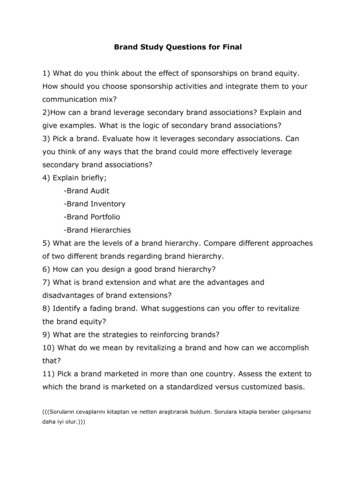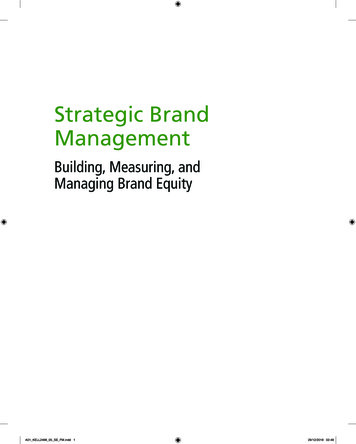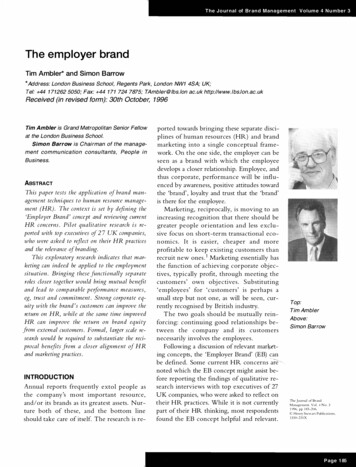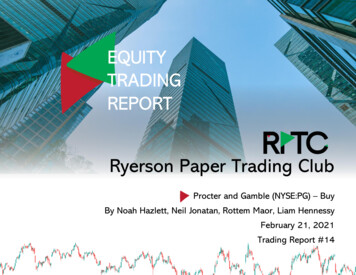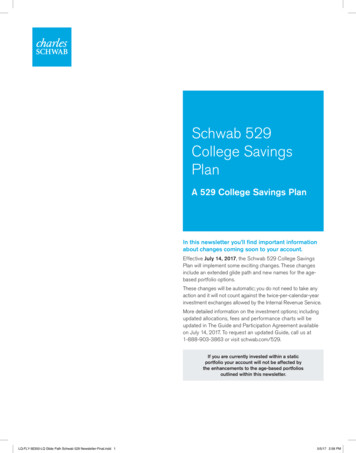
Transcription
CONSUMER PERCEPTION OF BRAND EQUITY MEASUREMENT:A NEW SCALESally Samih Baalbaki, BBA, MBADissertation Prepared for the Degree ofDOCTOR OF PHILOSOPHYUNIVERSITY OF NORTH TEXASMay 2012APPROVED:Francisco Guzmán, Major ProfessorAudhesh Paswan, Committee Member and PhDCoordinator for Marketing andLogisticsCharles Blankson, Committee MemberJames Conover, Committee MemberJeffrey Sager, Chair of the Department ofMarketing and LogisticsO. Finley Graves, Dean of the College ofBusinessJames D. Meernik, Acting Dean of theToulouse Graduate School
Baalbaki, Sally Samih. Consumer Perception of Brand Equity Measurement: A New Scale.Doctor of Philosophy (Marketing), May 2012, 92 pp., 18 tables, 3 figures, references, 123 titles.Brand equity is perhaps the most important marketing concept in both academia andpractice. The term came into use during the late 1980s; and the importance of conceptualizing,measuring, and managing brand equity has grown rapidly in the eyes of practitioners andacademics alike. This has resulted in several often-divergent view-points on the dimensions ofbrand equity, the factors that influence it, the perspectives from which it should be studied, andthe ways to measure it.Many different definitions and ways to measure brand equity have been proposed, andmost of them are based upon the definition: the added value with which a given brand endows aproduct. The two most influential conceptualizations of brand equity are Aaker and Keller.Aaker defines brand equity as a set of brand assets and liabilities linked to a brand, its name andsymbol, that add to or subtract from the value provided by a product or service to a firm and/orto that firm’s customers. Keller defines consumer-based brand equity (CBBE) as the differentialeffect of brand knowledge on consumer response to the marketing of the brand.Currently, all research on brand equity has used the same conceptualization of theconstruct based on previously determined dimensions with no attempt to argue their validity.Given the importance of the concept of brand equity in marketing, as well as the need for themeasurement of brand equity, the literature lacks an empirically based consumer-perceivedbrand equity scale. Since the brand is the consumer’s idea, the consumer is an active participantin the creation of equity for the brand. So if we want to understand and manage the intangibleequity directly, we have to have the consumer’s help.
This dissertation enriches and strengthens the current knowledge on brand equity bydeveloping a new conceptualization and scale determined by dimensions that consumersperceive. The new Consumer-Perceived Consumer-Based Brand Equity Scale is made up of fivedimensions: quality, preference, social influence, sustainability, and leadership. Previousconceptualizations of brand equity have discussed dimensions that are consumer descriptors.Since perceived brand equity is the value that consumers perceive in the brand, thisconceptualization presents dimensions that are brand characteristics.The new robust scale contributes both to the theoretical understanding of consumerbased brand equity measurement, as well as assisting managers, or brand ambassadors, inmeasuring brand equity and developing successful brand strategies. The value of aconsumer-perceived, consumer-based brand equity scale suggests a number of newdirections for study and elaboration in what is certain to be a compelling stream of researchwith vast implications for both theory and practice.
Copyright 2012bySally Samih Baalbakiii
ACKNOWLEDGMENTSLooking back, I am very grateful for all I have accomplished throughout these years inthe PhD program. It has certainly shaped me as a person and led me to where I am now.My heartfelt gratitude and appreciation goes to my dissertation committee. To my chair,Dr. Francisco Guzmán, I express my thanks for mentoring and encouraging me from my veryfirst semester as a doctoral student and guiding my development as an educator and a scholar. Ihave been very blessed with Dr. Guzmán’s patience, encouragement, support, and guidance. Ialso thank my committee members, Dr. Audhesh Paswan, Dr. Charles Blankson, and Dr. JamesConover for their helpful insights and guidance throughout this process. My thanks also go to Dr.Jeff Sager and all the other faculty members in the Department of Marketing & Logistics fortheir mentorship and stewardship during my time at the University of North Texas.It was a pleasure to share these years with wonderful colleagues, and I would like tosincerely thank them for having helped and encouraged me in various ways.My sincere thanks also goes to my family for always being there. I thank my mom for hernever-ending love, support, and encouragement. Special thanks for my dad, who always believedin me and supported all my decisions. I dedicate this dissertation to both my parents, withoutthem I would not be the person I am today. Finally, I want to thank my sisters who have beenthere for me throughout the years.Last, but not least, I would like to thank my husband for always being there for methrough all the good and bad times. Without his patience, support, strength, and love, I would nothave been able to successfully get through the program. I am grateful for having you in my life,Omar, and for our amazing gift from God, our daughter Jana.iii
TABLE OF CONTENTSACKNOWLEDGMENTS . iiiLIST OF TABLES . viLIST OF FIGURES . viiCHAPTER 1: INTRODUCTION .11.1.Introduction .11.2.Brand Equity .21.2.1. Definition of Brand Equity .21.2.2. Perspectives of Brand Equity .31.2.3. Brand Equity Perspective of this Dissertation .41.2.4. Principal Conceptualizations of Brand Equity . 51.3.Research Questions and Potential Contribution.51.4.Methodology .71.5.Outline of Dissertation .81.6.Conclusion .8CHAPTER 2: LITERATURE REVIEW .102.1.Introduction .102.2Brands and Branding.122.32.2.1Definition of a Brand .122.2.2The Evolution of Branding .14Brand Equity .142.3.1Definition of Brand Equity .142.3.2. Perspectives of Brand Equity .162.3.3. Brand Equity Perspective of this Dissertation .192.3.4. Principal Conceptualizations of Brand Equity .192.4.Brand Equity Measurement .222.4.1. Consumer-level Measures .222.4.2. Company-level Measures .232.4.3. Financial-level Measures .232.4.4. Customer Equity and Brand Equity .24iv
2.4.5. Academic Models .252.4.6. Industry Models .272.5.Brand Equity Scale Developments .292.5.1. Direct Approaches .302.5.2. Indirect Approaches .332.6.Gap and Contribution.37CHAPTER 3: METHODOLOGY AND ANALYSES .443.1.Introduction .443.2.Stages in the Development and Validation of a Scale Measuring ConsumerPerceived Brand Equity .443.2.1. Step 1: Identification of Dimensions of Brand Equity.453.2.2. Step 2: Generation of Items Representing the Dimensions .473.2.3. Step 3: Collection of Consumer Perceptions .493.2.4. Step 4: Scale Development and Purification.503.2.5. Step 5: Final Collection of Consumer Perceptions .513.2.6. Step 6: Assessment of Reliability and Validity of the Scale.513.2.7. Step 7: Identification of Consumer-Perceived Brand Equity Scale .60CHAPTER 4: DISCUSSION AND CONCLUSIONS .624.1.Introduction .624.1.1. Quality.624.1.2. Preference .634.1.3. Social Influence .644.1.4. Sustainability.654.1.5. Leadership .664.2.Theoretical Contributions .674.3.Managerial Contributions .704.4.Methodological Contributions .714.5.Limitations and Future Research Directions.72APPENDIX A: MEASUREMENT INSTRUMENT (1st STUDY) .75APPENDIX B: MEASUREMENT INSTRUMENT (2nd STUDY) .78REFERENCES .84v
LIST OF TABLES2.1.Functions of the Brand for the Consumer .132.2.List of Brand Equity Scales .413.1.Perceived Dimensions from Qualitative Study .463.2.Original Items in Survey .483.3.Composition of the Samples .513.4.Descriptive Statistics (student sample) .523.5.Exploratory Factor Analysis – iPhone (student sample).533.6.Exploratory Factor Analysis – Blackberry (student sample) .543.7.Exploratory Factor Analysis – HTC (student sample).553.8.Descriptive Statistics (consumer sample) .563.9.Reliability and Factor Structure (LISREL) Diagnostics .573.10.Evidence of Discriminant Validity – iPhone (consumer sample) .583.11.Evidence of Discriminant Validity – Blackberry (consumer sample) .593.12.Evidence of Discriminant Validity – HTC (consumer sample) .593.13.Evidence of Discriminant Validity – iPhone (student sample) .593.14.Evidence of Discriminant Validity – Blackberry (student sample) .593.15.Evidence of Discriminant Validity – HTC (student sample) .603.16.The New Consumer-Perceived Brand Equity Scale .61vi
LIST OF FIGURES1.1.Outline of the Dissertation .92.1.Brand Equity Diagram .183.1.Steps in Developing and Validating a Scale Measuring Consumer-Perceived BrandEquity .45vii
CHAPTER 1INTRODUCTIONA product is something that is made in a factory; a brand issomething that is bought by a customer. A product can be copiedby a competitor; a brand is unique. A product can be quicklyoutdated; a successful brand is timeless.- Stephen King, WPP Group London1.1. IntroductionThe concept of branding is centuries old. In ancient Egypt brick-makers would “brand”their bricks as a form of identification. Traders would “trademark” their products to guaranteequality to consumers. Brands, however, first appeared in the early sixteenth century. They wereused by whiskey distillers to “brand” their barrels when being shipped. The “brand” evolved inthe eighteenth century when producers’ names were replaced with names and pictures of placesof origin, animals, and famous people (Farquhar, 1989). This allowed for the strengthening of theassociation of the brand name with the product. Consumers were able to remember products aswell as differentiate between competitor products. Then, in the nineteenth century, brands wereused to enhance a product’s perceived value using associations. Branding evolved even further inthe twentieth century with new purposes and strategies.Why then are twenty-first century consumers willing to pay a premium for a product thatis branded versus a non-branded one? Why are they loyal to and love their brands? Consumersactually develop feelings and associations with brands and then become loyal to them due totheir “added value,” (i.e., their brand equity) (Barwise, 1993). Brands have become valuableassets to companies, and therefore, learning and understanding how to build, measure, andmanage brand equity is of utmost importance (Kapferer, 2005).Aaker’s (1991) and Keller’s (1993) conceptualizations of brand equity are the most well1
known and commonly adopted. Neither author, though, operationalized a scale for measurement.Therefore, many academics took to the task of quantifying this intangible asset. However, theseacademics use Aaker (1991) and Keller’s (1993) conceptualizations without coming up withtheir own or taking into account what mental resources consumers tap into in order to determinewhat characteristics of a brand are important to them (i.e., brand equity dimensions). Given theimportance of the concept of brand equity in marketing, as well as the need for the measurementof brand equity, the literature lacks an empirically based consumer-perceived brand equity scale(i.e., a marketing-oriented brand equity scale). Since the brand is the consumer’s idea, theconsumer is an active participant or partner in the creation of equity for the brand (Blackston,2000). Therefore, taking into account the consumer’s perspective in developing dimensions willallow us to understand, manage, and measure the intangible equity directly.The aim of this dissertation will be to develop and validate a new consumer-perceivedconsumer-based brand equity scale. This scale will provide a new conceptualization of brandequity (other than Aaker’s (1991) and Keller’s (1993) conceptualizations) and will use acomparison of a student and nationwide consumer sample in the development. Pursuant to theaim of the dissertation, a robust consumer-perceived consumer-based brand equity (CBBE) scaleis proposed.1.2. Brand Equity1.2.1. Definition of Brand EquityBrand equity is, if not the most, one of the most important marketing concepts for bothacademia and practice. Academics want to understand how brand equity is measured and what itmeans for a company, while practitioners want to understand how to influence consumer2
decisions with respect to different brand purchases in order to increase their brand equity. Theterm came into use during the late 1980s; and the importance of conceptualizing, measuring andmanaging brand equity has grown rapidly both for practitioners and academics alike (e.g. Aaker,1991, 1996; Aaker and Keller, 1990; Ailawadi et al., 2003; Erdem et al., 2006; Keller, 1993,2003; Netemeyer et al., 2004). This has resulted in “several often-divergent view-points on thedimensions of brand equity, the factors that influence it, the perspectives from which it should bestudied, and the ways to measure it” (Ailawadi et al., 2003 p. 1).Many different definitions and ways to measure brand equity have been proposed (seeChapter 2), and most of them are based upon Farquhar’s (1989) definition: “the added value withwhich a given brand endows a product” (p. 24). Brand equity is an important concept in businesspractice as well as in academic research because it can be used by marketers to gain competitiveadvantages through successful brands. Strong brand equity leads to opportunities for successfulbrand extensions, resilience against competitors’ promotional efforts, and the creation of barriersto competitive entry (Farquhar, 1989).1.2.2. Perspectives of Brand EquityBrand equity can be seen as emanating from three different perspectives. The first is thecognitive psychology perspective, which defines brand equity as the differential consumerresponse to a brand’s marketing mix that results from consumer associations for a brand (Aaker,1991; Keller, 1993). This perspective takes into account the fact that brands for which consumershave more favorable brand associations, or brands with higher brand equity, will be able togenerate more positive marketing mix responses from their consumers than brands with lessfavorable brand associations. Therefore, in terms of the cognitive perspective, brand equity is theresult of consumer responses to marketing activities, influenced by consumers’ brand3
associations (Anderson, 2007).The second perspective of brand equity is the information economics perspective, whichviews brand equity as the increased utility that a brand name gives to a product (Erdem andSwait, 1998; Wernerfelt, 1988). In this perspective, the brand name is a signal to consumers ofproduct quality; it is derived from perceived firm costs or investments, and this perceived qualityreduces information costs for the consumer, thereby increasing utility. This perspective isimportant in that it introduces the firm perspective into brand equity (Anderson, 2007).The third perspective of brand equity is the financial markets perspective, which definesfinancial-based brand equity (FBBE) as a financial measure of a firm’s market value minus thetangible asset value (Simon and Sullivan, 1993). The importance of this perspective lies in itsforward-looking measurement of brand equity.Although brand equity can be seen from three different perspectives, in general, it can beclassified into two broad categories: financial and consumer-based brand equity (CBBE) (Keller,1993). In addition, since brand equity affects and brings value to many stakeholders of acompany, a third category of brand equity has been recently proposed; employee based brandequity (EBBE) (King and Grace, 2009). King and Grace (2009) define EBBE as “the differentialeffect that brand knowledge has on an employee’s response to their work environment” (p. 130).Overall, the term consumer-based brand equity is usually used to refer to brand equity in general(Rajasekar and Nalina, 2008).1.2.3. Brand Equity Perspective of this DissertationThis dissertation will focus on the consumer-based brand equity (CBBE) perspective andwill not discuss FBBE or EBBE, as these two perspectives lie outside the scope of the proposed4
study. The rationale behind this decision is based on the following: the financial value of brandequity is ultimately the outcome of consumer response to a brand name. CBBE, on the otherhand, is the driving force of increased market share and profitability of the brand since it is basedon the market’s perceptions (Christodoulides and de Chernatony, 2010). The financial-basedperspective thus measures the outcome of customer-based brand equity; and therefore, we mustfirst understand CBBE in order to understand the other perspectives of brand equity.1.2.4. Principal Conceptualizations of Brand EquityThe two most influential conceptualizations of brand equity are Aaker’s (1991) andKeller (1993). Aaker defines brand equity as “a set of brand assets and liabilities linked to abrand, its name and symbol, that add to or subtract from the value provided by a product orservice to a firm and/or to that firm’s customers” (p.15). Aaker then proposes four dimensions ofbrand equity: brand awareness, brand loyalty, brand associations, and perceived quality. Keller(1993) develops the customer-based brand equity model (CBBE), which is the most widely usedmodel today. Keller defines CBBE by stating that the power of a brand rests on what the clientshave learned, felt, seen, and heard about it through time, that is, rests in their minds. Hence,CBBE is “the differential effect of brand knowledge on consumer response to the marketing ofthe brand” (p. 2). Keller’s (1993) definition of CBBE is used in arguing that brand equity ispositioned based on what consumers feel, see, and hear about the brand through time, therefore,the meaning of brand equity rests in the consumers’ minds.1.3. Research Questions and Potential ContributionCurrently, all research on brand equity has used the same conceptualization of the5
construct based on previously determined dimensions (i.e., based on the theoretical models ofeither Aaker, 1991 or Keller ,1993). A review of Aaker’s (1991) work expresses hisconceptualization of brand equity; and then, comments on the dimensions that Aaker discussesby stating “they are accepted largely on the basis of face validity and no attempt is made to arguetheir relative importance or possible interrelation” (Shocker,1993, p. 257). Therefore, developinga new conceptualization of CBBE, that focuses on the meaning of brand equity as it rests in theconsumers’ minds, is an opportunity to contribute to the field of marketing literature.This dissertation will enrich and strengthen the current knowledge on brand equity bydeveloping a conceptualization and scale determined by dimensions that consumers actuallyperceive. In other words, the aim of this dissertation is to develop the first Consumer-Perceived,Consumer-Based Brand Equity Scale. To date, there has not been an extensive examination ofthe consumer perceived dimensions that make up brand equity. Towards this end, thisdissertation attempts to answer the following key research questions:1. Which dimensions identified by consumers are critical to the development of theconsumer perceived brand equity construct?2. How can these dimensions be interrelated to measure brand equity effectively?By answering these questions, this dissertation will contribute both to the theoreticalunderstanding of consumer-based brand equity measurement, and assist managers, or brandambassadors, in measuring brand equity and developing successful brand strategies.This thesis maintains that, given the importance of the concept of brand equity in marketing, aswell as the need for the measurement of consumer perceived brand equity, the literature lacks anempirically based consumer-derived/perceived brand equity scale. Since the brand is theconsumer’s idea, the consumer is an active participant or partner in the creation of equity for the6
brand (Blackston, 2000). We thus need to understand what lies in consumers’ minds withrespect to brand equity. This leads us to the need for qualitative research to help unearth thesecrets of the “intangibility” of brand equity. In understanding the consumers’ real perceptions ofbrand equity, we will close the gap between what consumers perceive and what we currentlymeasure as brand equity.1.4. MethodologyThis dissertation is a scale development piece. It builds upon previous research on brandequity that has used the same conceptualization of the concept based on previously determineddimensions (i.e., based on either the Aaker 1991 or Keller 1993 theoretical models). A newconceptualization of brand equity based on consumer perceived dimensions will be presented. Inorder to develop a conceptualization and a scale determined by dimensions that consumersactually perceive, (i.e., the first consumer-perceived, consumer-based brand equity scale,) thefirst step was by determining these consumer-based dimensions using qualitative data from astudent sample and a nationwide sample of the U.S. population.This preliminary qualitative research was used to determine the most importantconsumer-based dimensions or constructs (Gummesson, 2005). The responses were analyzedusing a frequency count; and the most commonly found words are grouped together to formdimensions for perceived brand equity. The results indicate that the dimensions for perceivedbrand equity may have some commonalities with the existing conceptualizations (Aaker, 1991and Keller 1993), but also add new critical dimensions to the brand equity conceptualization thatdepicts brand equity as consumers perceive it today. The new perceived brand equity dimensionsfrom this preliminary study are: quality, loyalty, sustainability, and value.7
An online questionnaire was then used to measure the dimensions found using acombination of existing scales and newly developed items. Experts in the field ensured the faceand content validity of the survey. The first study was conducted on a student sample in order tovalidate the items in the survey. After refining the instrument, the survey was then tested usingboth a student sample and a nation-wide consumer sample. Finally, after analysis of reliabilityand validity, the new consumer-perceived brand equity scale is presented.1.5. Outline of DissertationIn order to address the proposed research questions, following Perry’s (1998) structuredapproach for presenting a thesis, this dissertation is organized into four chapters. First, anintroduction of the entire dissertation is presented. Second, the extant literature regarding brandequity and its measurement is reviewed in-depth and the gap in the literature is revealed. Third,the full-fledged scale development process is presented and analyzed. Finally, the researchimplications and suggestions for future research are discussed (see Figure 1.1.).1.6. ConclusionThis chapter laid the foundation for the dissertation. It introduced the research problemand questions, justified the research, presented some definitions, and briefly discussed andjustified the followed methodology. After having presented this outline, and based on thesefoundations, the dissertation can proceed with a detailed description of the extant literature inchapter 2.8
Figure 1.1.Outline of the Dissertation9
CHAPTER 2LITERATURE REVIEWA brand is the consumer’s idea of a product.- David OgilvyFactories rust away, Packages become obsolete, Products losetheir relevance. But great brands live forever.- Backer Spelvogel Bates2.1. IntroductionMarket orientation is an important concept in the marketing discipline, and is generallyunderstood as the implementation of the marketing concept, which has served as the discipline’sphilosophy since its formulation (McCarthy 1960). The marketing concept posits that marketingis the principal function of the firm, because the main purpose of any business was to create asatisfied customer (Levitt, 1960). It also emphasizes customer orientation and need satisfaction,as well as integration of a
Brand equity is perhaps the most important marketing concept in both academia and practice. The term came into use during the late 1980s; and the importance of conceptualizing, measuring, and managing brand equity has grown



